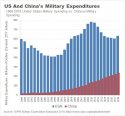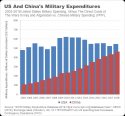I'm sure that the overall level of military spending will continue to increase going forward, but I am indeed suggesting that the proportion of funds allocated to new surface combatants will decline over time, such that real levels of funding for surface combatants may remain flat, or at least not increase dramatically over the coming decades.
China's surface combatants are already well ahead of the broader curve of Chinese military capabilities. China has been outbuilding USN in terms of surface combatants for more than a decade now: superior quantities and more or less comparable quality. Other segments such as nuclear submarines or strategic airpower are nowhere near competitive in terms of either quantity or quality. Some of that is a choice, reflecting a desire not to overcommit to platforms that are fundamentally uncompetitive. But nonetheless, what it means is that going forward, if China is to attain something like parity across the full spectrum of capabilities, dramatically greater funding is going to be required in those segments, significantly in excess of the growth delivered by the broader economy (and translated through to the overall defence budget).
China is not going to develop a robust strategic airpower capability in any useful timeframe by increasing current allocations to H-6, etc. by 5% per year. As research and development projects come to fruition the resources needed to turn those advancements into useful numbers of operational forces (i.e. replicating the boom in surface combatant construction that commenced in the mid-2000s) is going to require a doubling, tripling, quadrupling of prior expenditure, and over a quite short span of time. Those funds are going to come from somewhere, and it is very likely that they will come in part from a segment that is already tracking very well indeed: surface combatants. You can put nuclear-powered submarines in place of strategic airpower if you like.
I am not suggesting that there is going to be a "crash" in surface combatant construction, or that relatively flat funding for surface combatants going forward means a limited force. In the long-term, I think it is entirely plausible that PLAN will match USN in terms of blue water surface combatants, plus additional littoral combatants.
China's massive growth in surface combatants comes because China is in massive need for them due to its enormous coastal underbelly. Instead of needing less, it may even need more and more, because its not just China's coastal waters, regions, and claimed waters that need to be protected by also its trade routes. XJP's BRI ignited the acceleration for the PLAN to be transformed from a brown water to blue water.
In terms of surface combatants, what China does not need more is littoral seas brown water combatants. But it still is in great need for larger blue water combatants. Much of the 2010-2020 explosion in ships, a huge part lies with brown water combatants as opposed to larger blue water ships. You trim away the corvettes and then the frigates, and you will realize that the number of ships that can provide a wide area fleet air defense is much more limited vs. let's say US, Aus, UK and Japan combined. China might have been outpacing the US in terms of surface warship building, but the US has an enormous lead time in building its AEGIS destroyers and cruisers that there are 67 Burkes alone plus another 22 Ticos. That's way more than all the 052C, 052D, 055 and 054A combined. In addition to that, the 052C, 052D and 054A are underarmed with less missiles than a Burke. This actually spurs the need for more 055 and less of the other ships, other than an ASW oriented blue water ship like see below which you will also need.
As for nuclear submarines, no amount of budget will increase the number of output per year because you are limited to one facility that makes them, and it has to divide that output between attack subs and ballistic subs. The low number of nuclear attack subs isn't due to the lack of money, but because the facilities are too busy churning out nuclear ballistic subs instead. This requires a large offset using AIP powered SSKs that are built from another facility. Which is also, limited to one facility. Technically, there are two facilities that can make AIP powered SSKs, but the other facility would already be tied up making carriers and destroyers. Once again, putting more money isn't going to increase the number of SSKs you can make in a year because there is only one facility that makes it. Ironically, in order to counter the USN's submarine advantage, you have to resort to ASW oriented surface warships because it happens to be the surface ship industry that can scale up rapidly.
China's strategic airpower capability is limited because it lacks overseas bases. There is a limit to how much you can grow both the PLAAF and the PLANAF because you are tied to bases in the mainland. No matter how many planes you make, they are essentially much like your littoral brown water combatants --- they can't go far beyond the mainland and they can cover similar regions beyond the coast that can be covered by a fighter umbrella. Smaller planes like the J-10, they are even more limited. Instead of building more shorter ranged, local air defense aircraft, you shift the existing budget and production resources to building more longer ranged aircraft and UAVs. Building more H-6s? This is still an obsolete jet, and putting all your eggs into the H-6 basket is extremely risky because of its vulnerabilities.
In my view, even within the existing budgets you can optimize both navy and airforce by reducing shorter range and obsolete combatants and focusing on the longer ranged more advanced ones. You can grow numbers of J-16s, J-20s and 055s without sacrificing one or the other through reprioritizing.




